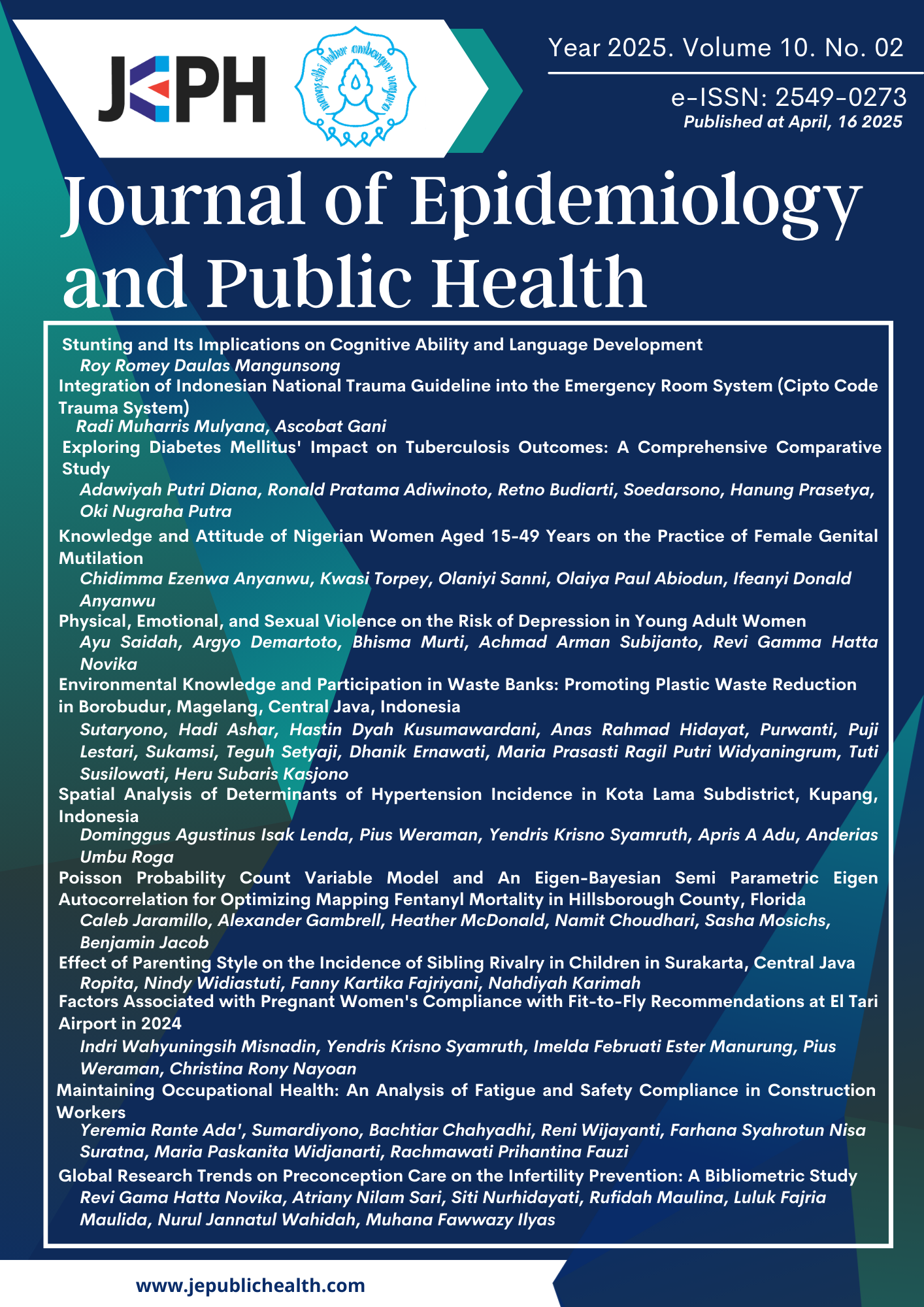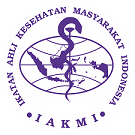Physical, Emotional, and Sexual Violence on the Risk of Depression in Young Adult Women
DOI:
https://doi.org/10.26911/jepublichealth.2025.10.02.05Abstract
Background: Depression due to dating violence is a serious problem that affects the mental health of many women, especially young adults. Dating violence, whether physical, emotional, or sexual, can interfere with psychological well-being and result in long-term consequences, one of which is depression. This study aims to analyze the relationship between experiences of dating violence and depression in victims, focusing on women aged 16 to 25 years.
Subjects and Method: This study was a cross-sectional study conducted in Surakarta from October to December 2024. The study sample consisted of 200 female young adults in Surakarta City, selected through random sampling. The dependent variable was depression., Independent variables were physical violence, emotional violence, and sexual violence. Data were collected using questionnaires and analyzed using path analysis on Stata 13.
Results: The risk of depression was directly influenced by emotional violence (b=0.49; 95%CI=0.39 to 0.60; p<0.001) and sexual violence (b=0.21; 95%CI=0.09 to 0.32; p<0.001). Meanwhile, the indirect influence was physical violence (b=0.28; 95%CI=0.15 to 0.41; p<0.001) and sexual violence (b=0.25; 95%CI=0.11 to 0.37; p<0.001).
Conclusion: Emotional violence and sexual violence directly affect the risk of depression. The indirect influence of the risk of depression is physical violence and sexual violence.
Keywords:
depression, physical violence, emotional abuse, sexual violenceHow to Cite
References
Astuti FD, Heriyanto MJ, Desvita WR, Rokhmayanti, Hastuti SKW, Utami BBK, Azka A (2024). Mental Health Screening for University Students in the Special Region of Yogyakarta. J Epidemiol Public Health. 09(03): 343-353. doi: 10.26911/jepublichealth.2024.09.03.08.
Axelta A, Abidin F (2022). Depresi Pada Remaja: Perbedaan Berdasarkan Faktor Biomedis Dan Psikososial. J Kesmas (Kes Masy) Khatulis. 9(1): 34–48. doi: 10.29406/JKMK.v9il.3207.
Callahan M, Tolman R, Saunders D (2003). Adolescent Dating Violence Victimization and Psychological Well-Being. J of Adolesc Research. 18(6): 664–681. doi: 10.1177/0743558403254784.
Cho S, Jang S (2021). Do Gender Role Stereotypes and Patriarchal Culture Affect Nursing Students’ Major Satisfaction?. Int J Environ Res Pub Health. 18(5): 1-9. doi: 10.3390/ijerph18052607.
Choudhary E, Smith M, Bossarte R (2012). Depression, Anxiety, and Symptom Profiles among Female and Male Victims of Sexual Violence. American J of Men’s Health. 6(1): 28–36. doi: 10.1177/1557988311414045.
Clare CA, Velasquez G, Mujica MGM, Fernandez D, Dinh J, Montague A (2021). Risk Factors for Male Perpetration of Intimate Partner Violence: A Review. Aggress Violent Behav. 56(1): 1-53. doi: 10.1016/j.avb.2020.101532.
Dinisman T, Moroz A (2017). Understanding Victims of Crime: The Impact of the Crime and Support Needs. Victim Support. 1(1): 1–40. doi: 10.13140/RG.2.2.17335.73124.
Dye H (2020). Is Emotional Abuse As Harmful as Physical and/or Sexual Abuse?. J of Child and Adolescent Trauma. 13(4): 399–407. doi: 10.1007/s40653-019-00292-y.
Gasperecz J, Baumler E, Wood L, Temple J (2023). Suicidal Ideation and Psychological Dating Violence Victimization: A Short Report. Frontiers in Psych. 14(1): 1–4. doi: 10.3389/fpsyt.2023.1105654.
Hamby S, Turner H (2013). Measuring Teen Dating Violence in Males and Females: Insights from the National Survey of Children’s Exposure to Violence. Psycho of Viol. 3(4): 323–339. doi: 10.1037/a0029706.
Hamilton A (2017). Understanding The Experiences of Woman Who Stay In Abusive Relationships. Conf proceed. 1(1): 4-19. https://hdl.handle.net/102-94/8320.
Han L, Xiao M, Jou M, Hu L, Sun R, Zhou Z (2020) The Long-term Effect of Media Violence Exposure on Aggression of Youngsters. Comput Human Behav. 106(1): 1-11. doi: 10.1016/j.chb.2020.106257.
Kearns MC, D’Inverno A, Reidy DE (2020). The Association Between Gender Inequality and Sexual Violence in the U.S.. Am J Prev Med. 58(1): 12-20. doi: 10.1016/j.amepre.2019.08.035
Kieling C, Baker-Henningham H, Belfer M, conti G, Ertem I, Omigbodun O, Rohde L, et al. (2011). Child and Adolescent Mental Health Worldwide: Evidence for Action. The Lancet. 378(9801): 1515–1525. doi: 10.1016/S0140-6736(11)60827-1.
Kumari V (2020). Emotional Abuse and Neglect: Time to Focus on Prevention and Mental Health Consequences. British J of Psych. 217(5): 597–599. doi: 10.1192/bjp.2020.154.
Labella M, Masten A. (2018). Family Influences on the Development of Aggression and violence. Curr O in Psych. 19: 11-16. doi: 10.1016/j.copsyc.2017.03.028.
Lestari PP, Abidin F, Abdin Z (2022). Bentuk Kekerasan dalam Berpacaran (KDP) dan Dampak Psikologisnya pada Wanita Dewasa Awal sebagai Korban Kekerasan. Martabat J Peremp dan Anak. 6(1): 65-84. doi: 10.21274/martabat.2022.6.01.65-84.
McNaughton R, Graham L, Chen M, Baron D, Gibbs A, Groves A, Kajula L, et al. (2021). Adolescent Dating Violence Prevention Programmes: a Global Systematic Review of Evaluation Studies. The Lanc Child and Adoles H. 5(3): 223–232. doi: 10.1016/S2352-4642(20)30276-5.
McNeil S, Andrews A, Cohen J (2020). Emotional Maltreatment and Adolescent Depression: Mediating Mechanisms and Demographic Considerations in a Child Welfare Sample. Child Development. 91(5): 1681–1697. doi: 10.1111/cdev.13366.
Nesset M, Lara-Cabrera M, Dalsbø T, Pedersen S, Bjørngaard J, Palmstierna T (2019). Cognitive Behavioural Group Therapy for Male Perpetrators of Intimate Partner Violence: a Systematic Review. BMC Psych. 19(1): 1-13. doi: 10.1186/s12888-019-2010-1.
Nyaboke R, Wafula L, Korir A, Chonge D, Mumbua S, Olpengs D, Mayoka G (2024). Mental Illness Among Women Attending A National Mental Health Referral Center in Kenya: Unpacking Predisposing Factors and Interventions. J Epidemiol Public Health. 09(02): 243-253. doi: 10.26911/jepublichealth.2024.09.02.10.
Offenhauer P, Buchalter A (2011). Teen Dating Violence: A Literature Review And Annotated Bibliography. The Livrary of Congres. 1(1): 1–92. doi: 10.1037/e726412011001.
Piolanti A, Foran H (2022). Efficacy of Interventions to Prevent Physical and Sexual Dating Violence among Adolescents: A Systematic Review and Meta-analysis. JAMA Pediatrics. 176(2): 142–149. doi:10.1001/jamapediatrics.2021.4829
Putu D, I Gusti Ayu Putu WB (2023) Faktor-Faktor yang Memengaruhi Resiliensi Remaja Pasca Dating Vio-lence: Sebuah Studi Literatur. Humanit (J Psikologi). 7(1): 113-124. doi: 10.28932/humanitas.v7i1.6086.
Ribeiro J (2018). Depression and Hopelessness as Risk Factors for Suicide Ideation, Attempts and Death: Meta-analysis of Longitudinal Studies. The British J Psych. 212(1): 279–286. doi: 10.1192/bjp.2018.27.
Senjaya A (2023). Increasing Awareness of Depression in Adolescents And Children Through Online Campaign Activities. J Layanan Masy. 7(3): 326–331. doi: 10.20473/jlm.v7i3.2023.326331.
Sholikhah R, Masykur A (2020). Atas Nama Cinta, Ku Rela Terluka (Studi Fenomenologi pada Perempuan Korban Kekerasan Dalam Pacaran). J Empati. 8(4): 706-716. doi: 10.14710/empati.2019.26513.
Silva F (2020). The Effects of Sexual Violence Experienced in Childhood and Adolescence on Undergraduate Students. Revista de Saude Publica. 54(1): 1–11. doi: 10.11606/s1518-8787.2020054002576.
Simon G (2003). Social and Economic Burden of Mood Disorders. doi: 10.1016/S0006-3223(03)00420-7.
Šincek D, Duvnjak I, Milić M (2017). Psychological Outcomes of Cyber-Violence on Victims, Perpetrators and Perpetrators/Victims. Hrvatska Revija Za Rehabilitacijska Istrazivanja. 53(2): 98–110. doi: 10.31299/hrri.53.2.8.
Taquette S, Leite D, Monteiro M (2019). Causes and Consequences of Adolescent Dating Violence : A Systematic Review. J Injury and Viol. 11(2): 137–147. doi: 10.5249/jivr.v11i2.1061.
Ullman S (2014). Trauma Histories, Substance Use Coping, PTSD, and Problem Substance Use among Sexual Assault Victims. Biochim Biophys Acta. 8(1842): 1219–1231. doi: 10.1016/j.addbeh.2013.01.027.Trauma.
Volpe E, Hardie T, Cerulli C (2012). Associations among Depressive Symptoms, Dating Violence, and Relationship Power in Urban, Adolescent Girls. JOGNN-J of Obstetric, Gynecologic, and Neonatal Nurs. 41(4): 506–518. doi: 10.1111/j.15526909.2012.01384.x.
WHO (2022). Mental Health II. World Health Organization.
WHO (2023a). Depressive Disorder (Depression). World Health Organization.
WHO.(2023b). Kerangka Kerja RESPECT, Pendekatan baru untuk Mengakhiri Kekerasan terhadap Perempuan di Indonesia. World Health Organization.



1.jpg)








